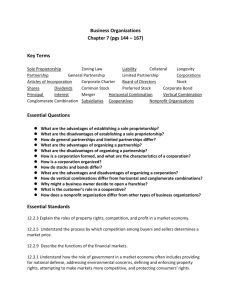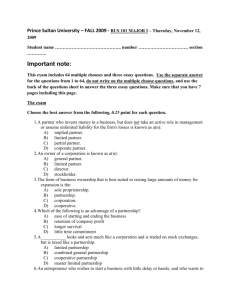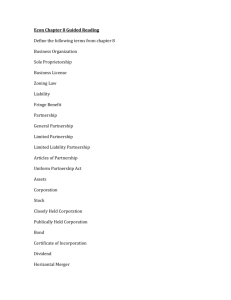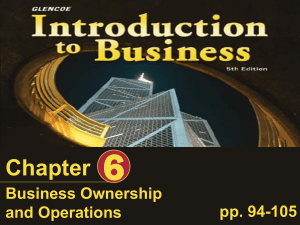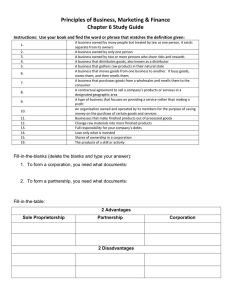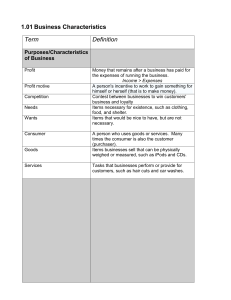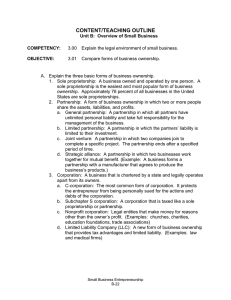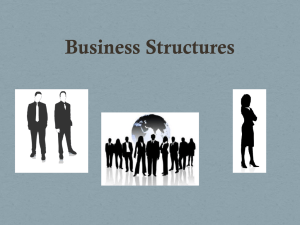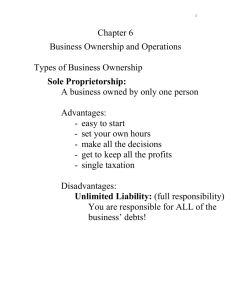Chapter 6
advertisement
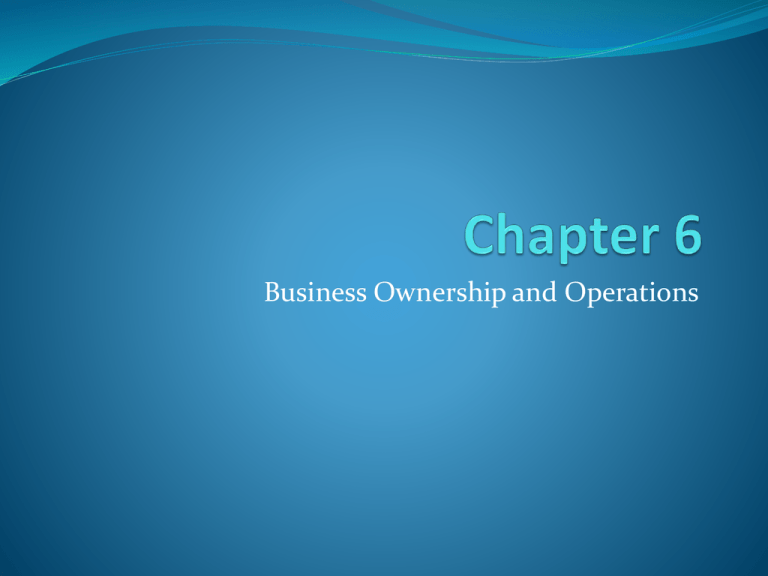
Business Ownership and Operations 6.1 Objectives Describe the advantages and disadvantages of the three major forms of business organizations. Describe how cooperatives and nonprofits are like and unlike corporations and franchises. Types of Ownership Three different types of ownership: Sole Proprietorship Partnership Corporation As your business expands and changes, can your type of ownership? Sole Proprietorship A business owned by only one person. About ¾ of all businesses in the United States. Textbook page 95 Figure 6.1 Why do some people want to own their own business? Respond in your notes. Advantages Easy to create Free to run the business as you see fit You retain the majority of the profits Disadvantages You must pay for everything yourself Lack of business skills Unlimited liability Full responsibility for the businesses debts. If you lose more money than you make, you have to make up the difference. Partnership A business owned by two or more persons. Each owner shares the risk and reward. Partnership agreement needed Contract outlining the rights and responsibilities of each partner. Advantages Easy to create Easier to obtain start-up money Skill diversity Disadvantages Share profits Unlimited legal and financial liability with your partners The actions of your partner(s) directly affects you Corporations A business (company) registered by a state and operates separately from its owners Corporate Charter A license to run a corporation Needed to form a corporation Obtained from the state your headquarters is in Corporations (continued) To raise money you can sell stock. Shares of ownership in your corporation Board of Directors Controls the corporation and makes major decisions Hires officers to control the day-to-day operations Advantages Limited liability If your company loses money, the stockholders lose only what they invested. Doesn’t end if the owner(s) die Raise money rapidly by selling shares. Disadvantages Pay more taxes Owners are taxed on their income from the corporation Closely regulated by the government Difficult to start Complicated operations and management What would you do? Imagine you and a friend invented a coffee mug that keeps the coffee at a constant temperature (so it never gets cold). You would like to sell this product and your friend wants to be your partner. Since he worked with you on the new invention, should you form a partnership with him? Why or why not? Identify and describe several advantages and disadvantages. Alternate Ways to Do Business There are three other ways to do business: Franchise Nonprofit Organization Cooperative Franchise Contractual agreement to sell a company’s products or services in a designated geographic area. Brainstorm! List all of the franchises you can think of that are in your neighborhood/area. Running a franchise: Invest money Pay the franchisor an annual fee or share the profits You receive a well-known name and business plan Can operate as a sole proprietorship, partnership, or even a corporation Advantages Easy to start Name of the parent company draws business Disadvantages Franchisor is often very strict on business operations Limited in what products or services you can offer Nonprofit Organization A type of business that focuses on providing a service rather than making a profit. Examples: American Red Cross, Meals on Wheels. Also, private hospitals, schools, and museums can be set up this way. No profit = no taxes Rely heavily on government grants and donations Cooperative An organization owned and operated by its members for the purpose of saving money on the purchase of certain goods and services. Example: Ocean Spray – a cooperative of cranberry growers. Exists as a separate entity from the individual businesses. Government Charter is needed to start one Can sell stock and choose a board of directors Cooperative (continued) Used by small farmers, book dealers, or antique merchants Can pool their resources together Save money by buying insurance, supplies, and advertising as a group. Pay less taxes Other examples: Ace Hardware and Welch’s Worksheet Pages 37 & 39 Complete the worksheets independently Compare your answers with a friend Be prepared to discuss Types of Businesses There are many different types of businesses and different ways to classify them. One way is to group them by the kind of products they provide: Producing raw goods Processing raw goods Manufacturing goods from raw or processed goods Distributing goods Providing services Producers A business that gathers raw products in their natural state. Raw goods – materials gathered in their original state from natural resources such as land or water. Industries include: Agriculture, mining, fishing, and forestry Processors Change the raw materials into more finished products. Example: Wheat is turned into flour, crude oil into gasoline, and iron ore into steel. May require further processing Manufacturers Businesses that make finished products out of processed goods. Turn raw or processed goods into finished goods that require no further processing and that are ready for the market. Example: Automotive plant makes cars out of steel, glass, and plastic. Intermediaries A business that moves goods from one business to another. It buys goods, stores them, and then resells them. A wholesaler (distributor) is an intermediary. Buys goods from a manufacturer in huge quantities and resells them in smaller quantities to their customers (usually other companies). A retailer purchases goods from a wholesaler and resells them to the consumer, or the final buyer of the goods. Service Business Provide services rather than goods Products of skill or an activity Examples: Hairstyling, car repair Employs about three-quarters of the workforce and is rapidly increasing. Worksheet Pages 36 & 40 Complete the worksheets independently Compare your answers with a friend Be prepared to discuss
